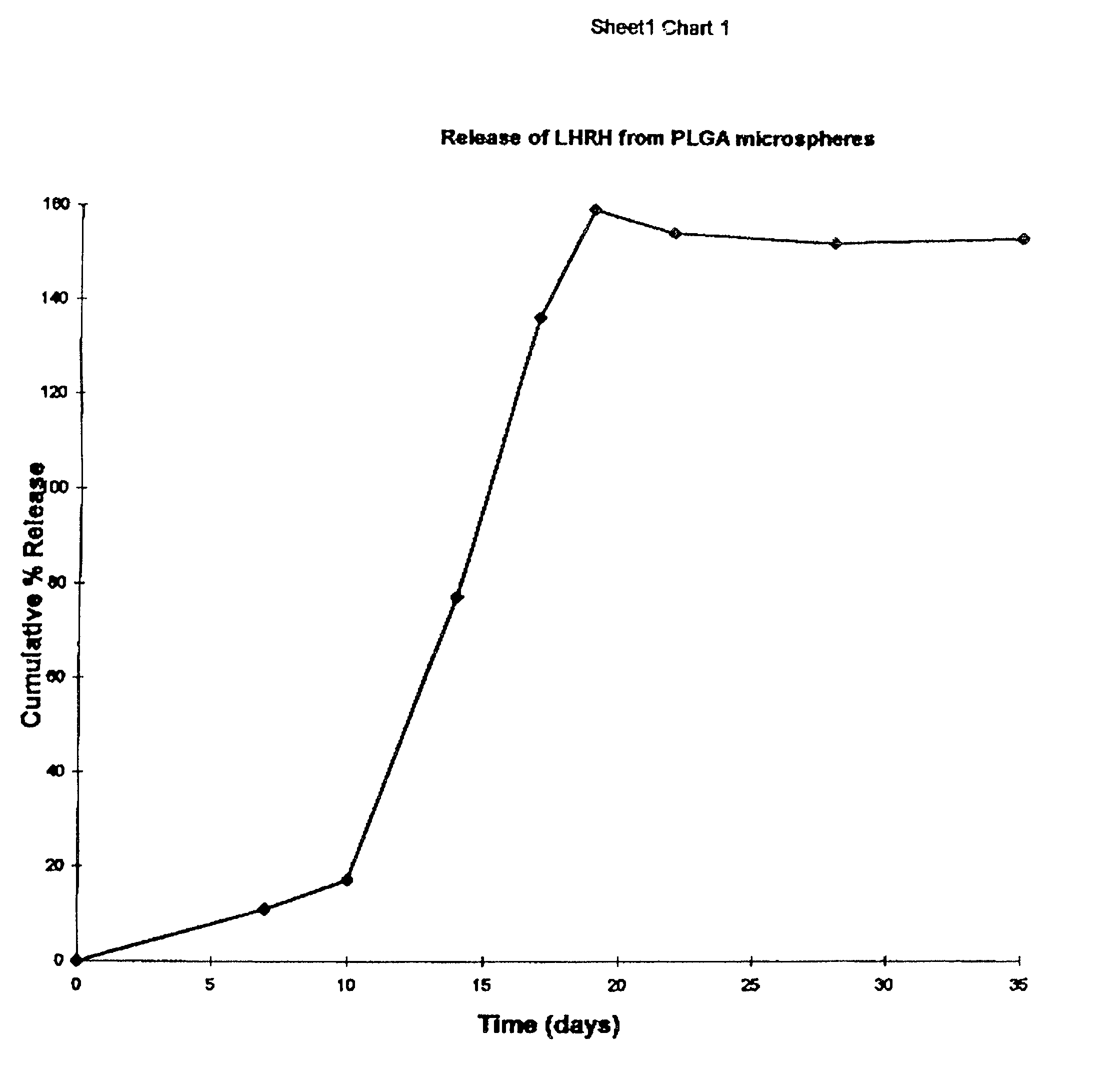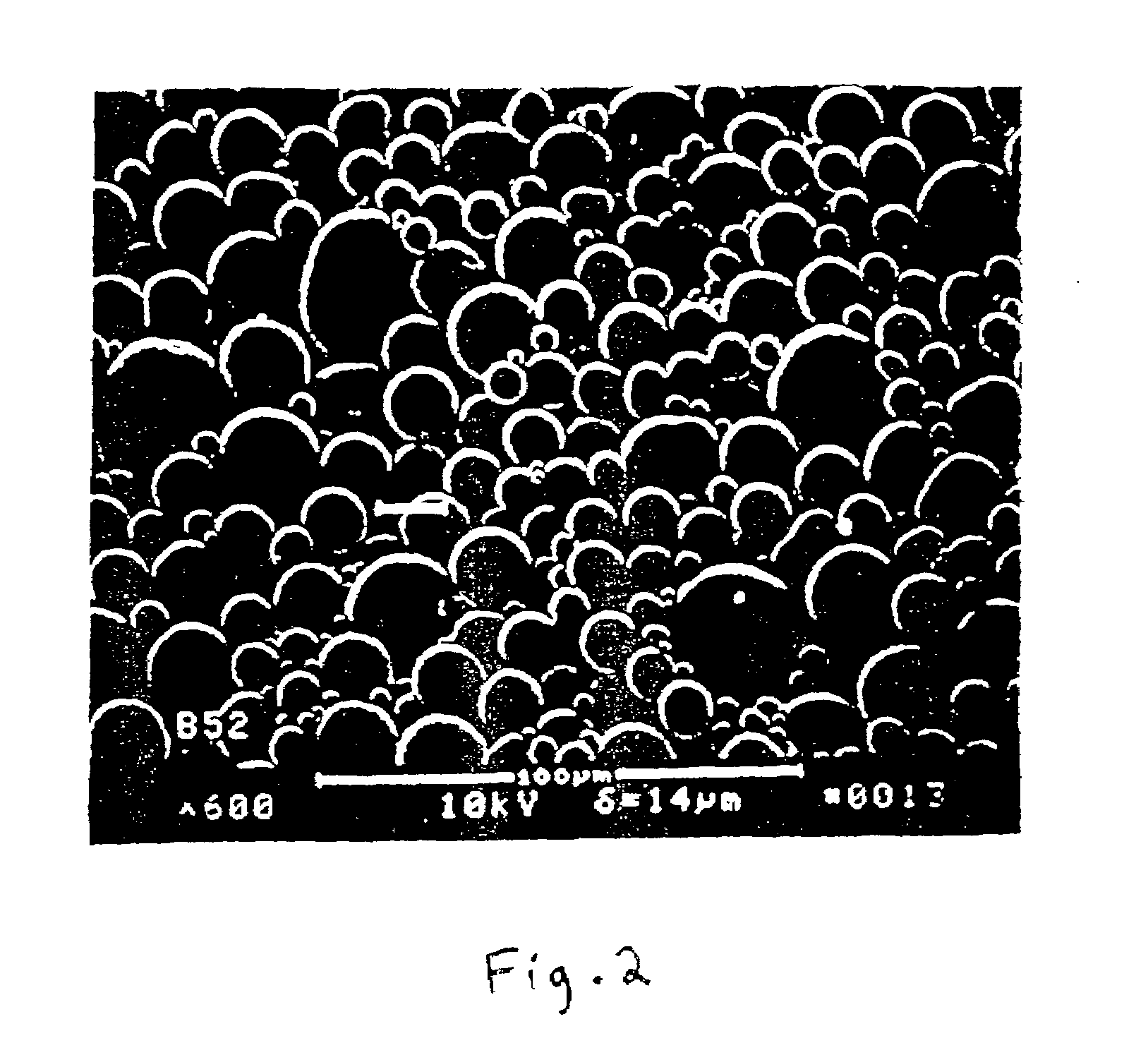"Burst-free" sustained release poly-(lactide/glycolide) microspheres
a poly-lactide/glycolide, burst-free technology, applied in the direction of microcapsules, capsule delivery, pharmaceutical delivery mechanism, etc., can solve the problems of poor encapsulation efficacy, end-capping of prior art use of plga copolymers, and blockage of terminal carboxyl end groups, etc., to achieve high encapsulation efficiency
- Summary
- Abstract
- Description
- Claims
- Application Information
AI Technical Summary
Benefits of technology
Problems solved by technology
Method used
Image
Examples
example 1
[0121]Polylactide / glycolide (PLGA) microcapsules are prepared by a unique aqueous emulsification technique which has been developed for use with the uncapped polymer to provide superior sphere morphology, sphere integrity and narrow size distribution (See FIGS. 2 and 4). This is accomplished by dissolving the polymer in a chlorinated hydrocarbon solvent such as methylene chloride and dissolving the biologically active agent in water. A w / o emulsion is then formed by mixing the solutions of polymer and the active agent by sonication, followed by emulsion stabilization in a solvent—saturated aqueous solution containing polyvinyl alcohol. A ternary emulsion is then formed by emulsifying the w / o emulsion in an external, pre-cooled aqueous phase containing polyvinyl alcohol (0.25–1% w / v). Microcapsules are hardened upon removal of solvent by evaporation, rinsed to remove any residual emulsifier, and then lyophilized.
[0122]Table 1 lists the microcapsule compositions, Nos. 1–21 thus prepar...
example 2
[0123]Microcapsule compositions are prepared as described in Example 1 wherein the copolymer L / G ratio is 48 / 52 to 52 / 48, and the ratio of uncapped / capped polymer is 100 / 0. The active core is Histatin (Mw 1563), the polymer molecular weight is <15,000 and the polymer concentrations vary from 7% to −40% w / w. Compositions 1,2,4 12–14 and 16–18 are listed in Table 1.
[0124]Release profiles of the active core from the compositions in an aqueous physiological environment, such as phosphate-buffered saline, pH 7.0 maintained at 37±1° C. are plotted as cumulative percentage release versus time, and presented in FIG. 5.
[0125]Burst-free, variable release from 1–35 days is achieved by varying the polymer concentration from 7 to ˜40% w / w in the oil phase.
example 3
[0126]Microcapsule compositions are prepared as described in Example 2, wherein the aqueous / oil ratio is varied from 1 / 4 to 1 / 20 (v / v). Compositions 1,2,4 and 12 are listed in Table 1.
[0127]Release profiles of the active core from the compositions in an aqueous physiological environment described in Example 2 are plotted as cumulative percentage release versus time, and presented in FIG. 5.
[0128]Burst-free, continuous release from 1–35 days, with different onset and completion times are achieved by selecting different w / o ratios in the inner core.
PUM
| Property | Measurement | Unit |
|---|---|---|
| Size distribution | aaaaa | aaaaa |
| Temperature | aaaaa | aaaaa |
| Temperature | aaaaa | aaaaa |
Abstract
Description
Claims
Application Information
 Login to view more
Login to view more - R&D Engineer
- R&D Manager
- IP Professional
- Industry Leading Data Capabilities
- Powerful AI technology
- Patent DNA Extraction
Browse by: Latest US Patents, China's latest patents, Technical Efficacy Thesaurus, Application Domain, Technology Topic.
© 2024 PatSnap. All rights reserved.Legal|Privacy policy|Modern Slavery Act Transparency Statement|Sitemap



